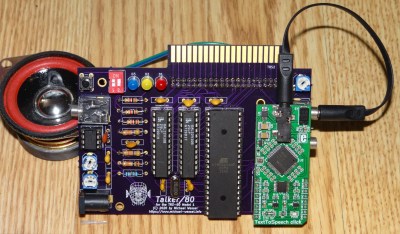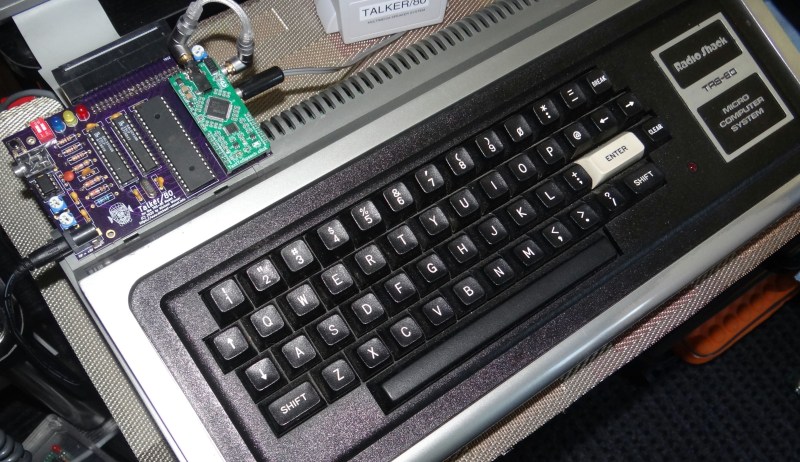Like artificial intelligence, speech synthesis was one of those applications that promised to revolutionize computing in the 1980s, only to fizzle out after people realized that a robotic voice reading out predefined sentences was not actually that useful. Nevertheless, computer manufacturers didn’t want to miss out on the hype and speech synthesizers became a relatively common add-on for a typical home computer.
Those add-ons were usually built around a custom voice-synthesis chip. If that chip fails, you’re out of luck: many were made in limited quantities by small companies and are impossible to find today. So if you’ve got a Tandy TRS-80 Voice Synthesizer with a dodgy SC-01-A chip, you’ll definitely want to check out [Michael Wessel]’s Talker/80 project. It’s a plug-in module for the TRS-80 that’s software compatible with the original Voice Synthesizer, but built from modern components. Synthesis is still performed by a custom IC, but now it’s using the more common Epson S1V30120 text-to-speech chip.
 The Talker/80 also has an ATmega644, which connects to the TRS-80’s expansion port on one side and to the Epson chip on the other. It can either emulate the original SC-01-A, in which case it expects text to be split into separate phonemes, or it can be set to an “advanced” mode in which it can directly process normal English text. In either case the voice sounds quite different from what original, although the new voice is arguably a little clearer.
The Talker/80 also has an ATmega644, which connects to the TRS-80’s expansion port on one side and to the Epson chip on the other. It can either emulate the original SC-01-A, in which case it expects text to be split into separate phonemes, or it can be set to an “advanced” mode in which it can directly process normal English text. In either case the voice sounds quite different from what original, although the new voice is arguably a little clearer.
We’ve seen modern speech synthesizers made for several classic computers: you can hook up the same Epson chip to an Amstrad CPC, or an ESP8266 to a VIC-20. If you’ve got an actual working SC-01-A but no vintage computer to use it with, you can also control it with an Arduino.

















I never had a TRS-80, other than a Model 100. And I never had a voice synthesizer.
They were one more thing companies could sell to people. At a time when there were limits to practical use of computers, a voice synthesizer was exciting, beause it had no use either. But yiu could play with it.
Steve Ciarcia covered voice synthesis a few times. Early issues of Byte had articles about how the voice worked, and the very primitives needed. Radio Shack sold a voice synthesizer IC.
But there were articles about computer music, robots, using computers to keep track of recipes. It was a blank slate, people got computers as an end in itself, and then explored what to use them for. It wasn’t about practical.
I used the Radio Shack chip (The SP0256) to make a synthesizer for my Atari 800, I think I may even still have the chip around here someplace.
My first computer, a TI 99/4A had a voice synthesis module that worked with some of the game cartridges. Anyone remember Parsec? “Nice shot, pilot!”
About 15 years ago I built a voice synth box for my Commodore 64 using the SPO256 chip. Still have a few in a drawer for future evil projects…
Around a year ago I found a TI-99/4A Voice Synthesizer Module at a 2nd hand store. (i’m not sure what I paid for it)
It looked like it had never been used. So, I bought it and sold it for a reasonable price to someone who could use it.
I still have that voice chip that RadioShack sold in a blister pack 20-30 years ago.
I have never used it.
I had one of those kicking around at some point. Also that speech recognition chip that was supposed to recognise about a dozen commands… I grabbed them cheap when there was one of those rebranding sales (Clearing everything out because they’d changed logos/colors etc) and was saving them for “just the right project” but apparently that didn’t happen yet.
For all I know they’re boxed up somewhere still but it was some moves ago I last saw them.
Interesting, an original “model 1” with the expansion interface, but without the keypad. Mine had the keypad but I never got the EI, too costy. And of course it’s long gone now. But it sure looks retro with that giant badge instead.
I think late-production Model I (like mine) came with the keypad. Didn’t others get the keypad as part of the LI-LII upgrade if you sent it back to have Tandy do it?
definitely tsr80, psion 5 , newton, rexx pcmcia or sony palm ux50 (small) and vaio pocket wide screen are top of needing and still good machines.
Why nobody create similar wirb modern components?
WHY!?